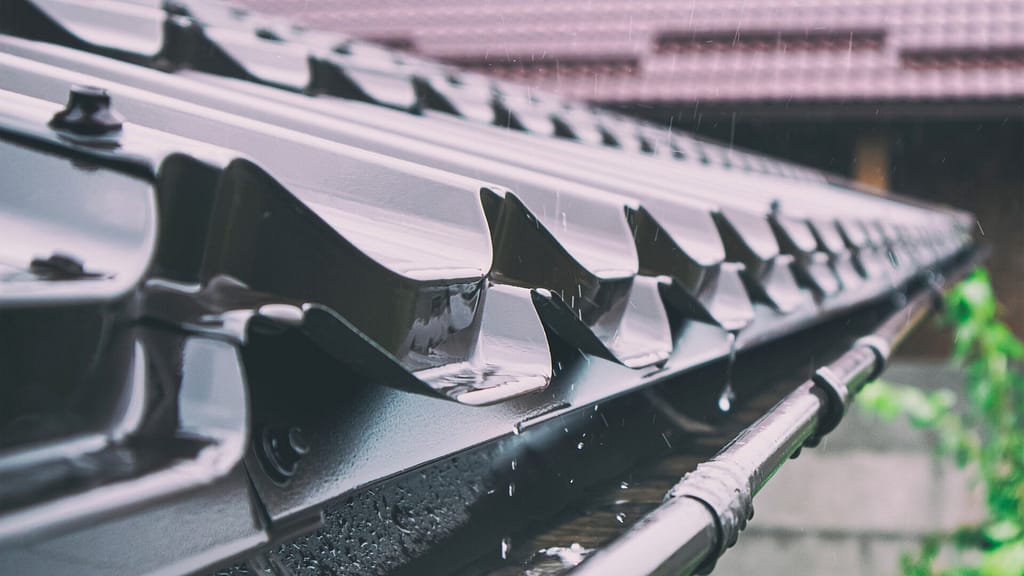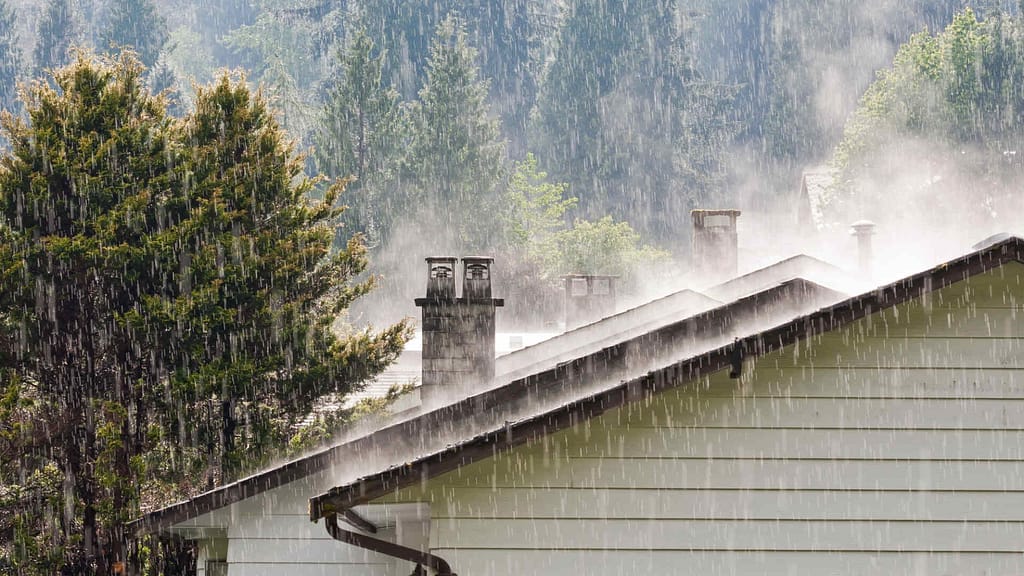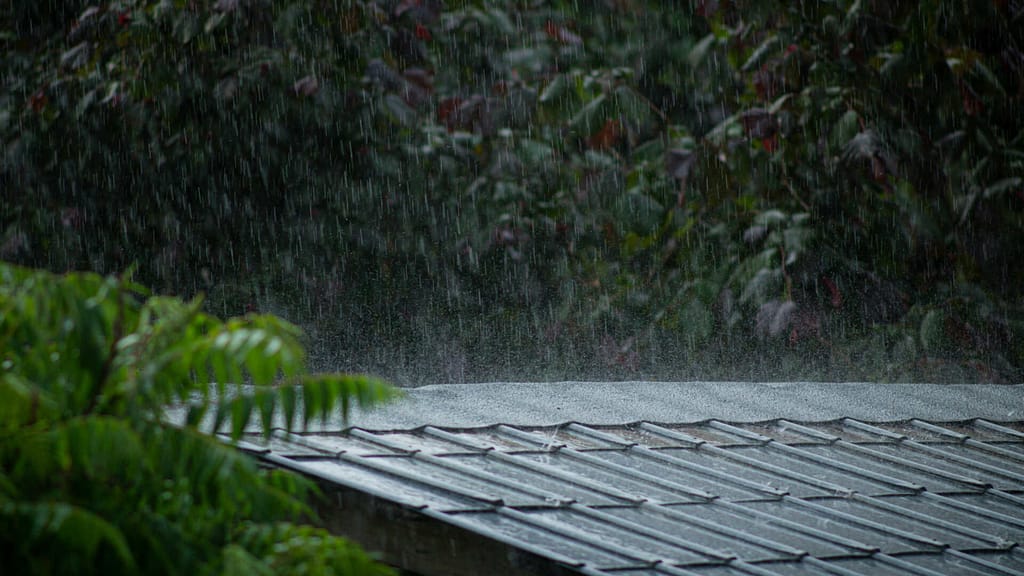Choosing the best roof for a rainy climate involves considering water resistance, durability, and design. Metal roofs excel with their water-shedding capabilities, but understanding various materials and shapes ensures you find the perfect fit for your home.
Table of contents
Key Factors to Consider in Rainy Climates
Choosing the right roof involves understanding several critical factors that impact its performance in rainy conditions. From water resistance to drainage capabilities, knowing what to look for will ensure you select a roof that meets your needs and withstands the challenges of a wet climate.
Water Resistance
Water resistance is perhaps the most important factor to consider when choosing a roof for a rainy climate. A water-resistant roof ensures that rainwater does not seep into your home, preventing leaks and water damage.
- Material Choice: Go for materials known for their water resistance, such as metal or slate.
- Sealing: Ensure proper sealing around joints and edges to prevent leaks.
- Overlapping Shingles: Use overlapping shingles to direct water away from vulnerable areas.
Durability
Durability refers to the roof's ability to withstand harsh weather conditions, including heavy rain, wind, and storms. A durable roof will have a longer lifespan and require less frequent repairs.
- Strong Materials: Consider materials like metal, slate, or concrete tiles known for their strength.
- Weatherproofing: Look for roofs with weatherproof coatings or treatments.
- Warranty: Choose products with a strong warranty to ensure quality and durability.
Slope and Drainage
The slope of the roof plays a critical role in how well it handles rain. A steeper slope allows rainwater to flow off the roof more quickly, reducing the risk of water pooling.
- Steep Slope: Opt for a roof design with a steep slope for better water runoff.
- Gutter Systems: Install efficient gutter systems to guide water away from the home.
- Regular Maintenance: Keep gutters clean and free of debris to maintain proper drainage.
Best Roofing Materials for Rainy Climates

Different roofing materials offer various benefits and drawbacks, particularly when it comes to handling wet weather. In this section, we will explore some of the best materials suited for rainy climates, each with its unique characteristics and advantages.
Asphalt Shingles
Asphalt shingles are a popular choice for many homeowners due to their affordability and effectiveness in rainy climates. They are widely available, easy to install, and offer good water resistance.
However, asphalt shingles may require more maintenance over time compared to other options. Some types can be prone to algae growth, which can affect their appearance and performance.
Metal Roofing
Metal roofing is an excellent choice for rainy climates due to its strength and longevity. It sheds water quickly and withstands harsh weather conditions, making it highly water-resistant and low maintenance. Metal roofing materials include options like aluminum, steel, and copper, each offering unique properties. However, one consideration with metal roofing is that it can be noisy during rainstorms unless properly insulated.
If you're considering a metal roof for your home, you can use our Metal Roof Cost Calculator to instantly learn the cost and make an informed decision.
Slate Tiles
Slate tiles offer a natural and elegant look while providing outstanding water resistance and durability. Known for their longevity and visual appeal, slate tiles are highly durable and can withstand the challenges of wet climates. However, they are quite heavy and may require additional structural support, which can increase installation costs.
Clay and Concrete Tiles
Clay and concrete tiles are known for their durability and aesthetic appeal, making them excellent choices for wet climates. They are strong, weather-resistant, and long-lasting, providing reliable protection against rain. These tiles are also heavy and require strong structural support, which may add to the cost of installation.
Synthetic Roofing Materials
Synthetic roofing materials, such as rubber or plastic composite shingles, are becoming popular for their versatility and environmental benefits. These materials are lightweight, water-resistant, and often made from recycled materials, making them an eco-friendly option. Synthetic roofing options include synthetic slate, rubber, and plastic composites, each offering unique benefits
The Best Roof Shapes for Rainy Climates

In addition to selecting the right materials, choosing the appropriate roof shape is crucial for maximizing your roof's performance in rainy climates. The shape of your roof plays a significant role in how well it manages water runoff, preventing leaks and potential water damage. Let's explore some of the best roof shapes for regions with heavy rainfall.
Gable Roof
The gable roof is one of the most popular and effective shapes for rainy climates. Characterized by its triangular shape, this roof design allows rainwater to easily run off both sides. The steep pitch of a gable roof ensures that water does not pool on the surface, reducing the risk of leaks and structural damage. Discover more about gable roofs in our blog post, "What is a Gable Roof?"
Hip Roof
A hip roof is another excellent choice for rainy climates. This roof shape features slopes on all four sides, which converge at the top to form a ridge. The even distribution of slopes allows water to quickly run off in multiple directions, making it highly effective in managing heavy rainfall.
Mansard Roof
The mansard roof, with its two slopes on each side, is not only visually appealing but also practical for rainy climates. The lower slope is typically steeper, allowing for efficient water runoff, while the upper slope is more gentle. This design not only helps in shedding water but also creates extra living or storage space within the attic.
Saltbox Roof
The saltbox roof is an asymmetrical design with one long slope and one shorter slope, creating a distinctive profile. This shape is particularly effective in shedding rainwater quickly, as the long slope facilitates rapid drainage. The saltbox roof's unique design can also withstand strong winds, making it suitable for areas prone to storms.
Shed Roof
A shed roof, characterized by its single sloping surface, offers a modern and minimalist aesthetic while providing excellent water drainage. The steep angle of a shed roof allows rainwater to flow off effortlessly, preventing water accumulation and leaks. This roof shape is ideal for smaller structures or extensions, and its straightforward design makes it easy to construct and maintain.
Additional Considerations for Rainy Climates

In addition to choosing the right materials, there are other important considerations that can enhance your roof's performance in rainy climates. These include protective coatings, maintenance routines, and proper insulation and ventilation, all of which contribute to a well-functioning and durable roof.
Roof Coating
Applying a roof coating can significantly enhance water resistance and extend the life of your roof. Roof coatings create a barrier against moisture and can also help reflect heat, making your home more energy-efficient. Common types of coatings include acrylic, silicone, and asphalt, each offering specific benefits. For the best results, consider having the coating professionally applied to ensure even coverage and maximum effectiveness.
Insulation and Ventilation
Proper insulation and ventilation are also crucial for preventing moisture buildup inside the home, which can lead to mold and rot. Ensuring adequate insulation helps keep the home dry and energy-efficient by reducing heat loss and preventing condensation. Installing vents can promote airflow and further reduce the risk of moisture accumulation. Using vapor barriers is another effective strategy for managing indoor humidity levels and maintaining a healthy indoor environment.
Regular Maintenance
Regular maintenance is essential to keeping your roof in top condition, especially in rainy climates. Scheduling regular roof inspections can help catch potential issues early before they develop into major problems. It’s also important to keep gutters and downspouts clean to prevent water buildup, which can lead to leaks and structural damage. Additionally, promptly repairing any damage to shingles, flashing, or other roof components can prevent minor issues from becoming costly repairs.
Conclusion
When deciding on the best roof for a rainy climate, it's important to choose materials and shapes that handle water well. Metal roofing is the top choice because it is great at shedding water and is very strong. It doesn’t require much maintenance, making it ideal for areas with heavy rainfall. Other materials like asphalt shingles, slate tiles, and synthetic options also work well, but metal stands out for its ability to resist water damage over time.
The shape of the roof is also crucial. Roof designs like gable and hip roofs are excellent for rainy climates because they allow water to run off easily. A gable roof, with its triangular shape, and a hip roof, with slopes on all sides, are both effective at preventing water from pooling on the surface. By combining metal roofing with a suitable shape like a gable or hip roof, you can ensure your home is well-protected against rain. Consulting with a roofing expert can help you make the best choice for your home and climate. Additionally, you can use our Roof Cost Calculator to get an estimated price for materials based on your specifications.
Fact checked by Adrian Catolico - 8/6/2024

